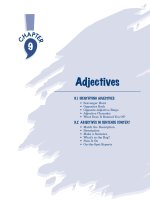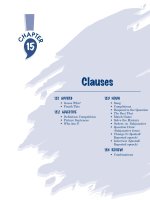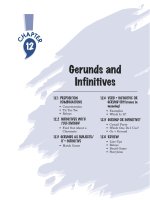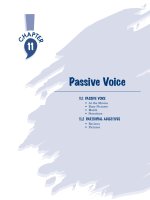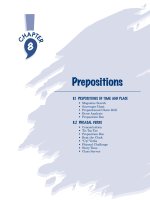fun With Grammar - Modals
Bạn đang xem bản rút gọn của tài liệu. Xem và tải ngay bản đầy đủ của tài liệu tại đây (307.45 KB, 19 trang )
Modals
10
10.1 MODALS
• Dialogue Advice
• Line-Ups
• What Can I Do with It? (Using can)
• Are You the One? (Using can)
• Stop Me, Please!
• Role Play
• Class Rules
10.2 PAST PROGRESSIVE MODALS
• Knock at the Door
10.3 REVIEW
• Board Game
• Riddles
• Modal Madness
197
10.1 MODALS
1. DIALOGUE ADVICE
Materials:
None
Dynamic:
Teams
Time:
10 minutes
Procedure:
1. Divide the class in half, and have the students form two lines on
either side of the classroom. The first student in each line then
comes to the center of the room.
2. The two students converse with each other as in the examples,
with one student stating a problem, and the other giving advice.
Examples:
Student A: What’s wrong?
Student B: I have a headache.
Student A: You should go home and take some aspirin.
Student A: What’s the matter?
Student B: I have to take my driver’s license test, but
my car isn’t working.
Student A: You should try to postpone the test.
4. The two students then go to the ends of their respective lines, and
the next two students converse. Continue the play until all
students have had a chance, or until you reach a certain time limit.
NOTE: You may want to give the class a topic, such as health, family
matters, or transportation, or leave the conversation open-ended.
2. LINE-UPS
Materials:
Worksheet 61
Dynamic:
Whole class
Time:
20 minutes
Procedure:
1. Copy the worksheets (using two colors of paper) and cut them into
individual cards so that you have one card for each student, or
make your own 3”x5” cards in two colors. (Using two colors
makes it easier to give directions and see that everyone is where
he/she should be.) You will need only one worksheet if you have 12
or fewer students.
2. Call all students holding one color card to the front of the class
and have them form a line. This is the question line. The other
students come forward and stand in front of a student in the
question line.
3. The students in the question line read the questions on their cards
to the classmates in front of them. The students in the answer line
must give advice. After answering a question, the students in the
answer line move to the next position. The students in the
question line do not move. Continue until the students in the
answer line are back where they started (they have given advice to
all the students in the question line). Now the students change
positions. The students who answered questions are now the
question line. They take out their cards to ask questions, and the
opposite students answer.
4. As a follow-up, ask each student to summarize the kind of advice
he/she received. In a lower class, you might just ask each student
for one piece of advice he/she received.
3. WHAT CAN I DO WITH IT? (Using
can
)
Materials:
None
Dynamic:
Whole class
Time:
10 minutes
Procedure:
1. Explain that a volunteer will leave the room. While this student is
gone, you will give the class a word. When the volunteer returns,
he/she will try to guess the word from class clues. The students
will give clues using “can.”
2. When everyone understands the game, ask for a volunteer to
leave. Write a word on the board and solicit clues from the class.
Example: Word: eggs
Clues: You can find them on a farm.
You can cook them.
They can break if you drop them.
If you want, go over strategy, such as using more general clues
first and saving very specific ones (such as “They can be found
under chickens”) until last.
3. When you have solicited approximately five clues, erase the words
on the board and call the volunteer back in. The class members
take turns giving their “can” clues. The volunteer tries to beat the
class by guessing the word before all the clues are given.
SUGGESTED WORDS: eggs, fish, aspirin, gloves, paper clips, bicycle,
thermometer, turn signal
198
199
4. ARE YOU THE ONE? (Using
can
)
Materials:
Worksheet 62
Dynamic:
Whole class
Time:
20 minutes
Procedure:
1. Give every student a copy of the worksheet.
2. The object is for students to find someone who can give them a yes
answer to each question. When they get a yes they write that
student’s name in the space. If they get a no answer, they continue
to search for someone who will say yes.
3. Go over some of the answers as a closure.
NOTE: This same idea can be used with Human Bingo. See Chapter
Five for sample worksheets of both Are You the One? and Human
Bingo.
5. STOP ME, PLEASE!
Materials:
Bottles to use as props
Dynamic:
Whole class
Time:
10 minutes
NOTE: This short warm-up or review activity involves the entire
class, but takes only 5–10 minutes.
Procedure:
1. Begin by telling the class they can speak to you using negative
modals only. On the board, list several possibilities, such as
You don’t have to . . .
You must not . . .
You don’t need to . . .
You should not . . .
2. Set up a group of small bottles in front of you. On one, attach a
skull and crossbones picture, or write the word poison on an easy-
to-see label.
3. Tell the students that you need to put eyedrops in your eye (or
take some aspirin, etc.), but you don’t have your contact lenses in,
so you can’t see very well.
4. Pick up the bottle with the poison label, saying “This must be the
right bottle!,” and act as if you are going to use it. If no one tries to
stop you, draw out the activity a little longer before finally asking
if anyone has something to say to you. (You might say “Is this the
right bottle?” “Can anyone help me? I can’t read the label.” or “Do
you think this is the right one?”)
6. ROLE PLAY
Materials:
Worksheet 63
Dynamic:
Pairs
Time:
20 minutes
Procedure:
1. Put students into pairs, and give each pair a card from the cut-up
worksheet.
2. The pairs read their situation and plan a role play. They must use
some modals in their role play, but are not limited to any in
particular.
3. Check with the pairs to see how they are doing. When everyone is
prepared, the pairs come to the front and role play their
situations. The class states what situation is being portrayed.
7. CLASS RULES
Materials:
None
Dynamic:
Small groups
Time:
10 minutes
Procedure:
1. Divide the class into groups of three or four.
2. The groups are to make a list of rules for the class that are fair for
both students and teacher. Encourage them to use modals and the
future.
3. A member of each group writes the group’s rules on the board. As
a class, decide which rules they would all accept.
10.2 PAST PROGRESSIVE MODALS
1. KNOCK AT THE DOOR
Materials:
3”x5” cards
Dynamic:
Pairs
Time:
20 minutes
Procedure:
1. Model two or three Knock at the Door situations.
200
201
Examples:
Teacher: I knocked at my friend’s door at 6:30 this
morning. He came to the door with a razor in
his hand, wearing half a beard and half a
mustache.
Student: He must have been shaving.
Teacher: I knocked at my friend’s door at 10:30 last
night. She came to the door with the TV remote
control in her hand, and I could hear loud
music in the background.
Student: She must not have been studying for the big
grammar test we have today.
2. Put students in pairs and have each pair write 3–5 Knock at the
Door situations on their index cards.
3. Circulate and circle the two best situations on each card. Have the
student pairs share them with the class.
SUGGESTION: Instead of step 3, the pairs can pick their two favorite
situations to share with the class.
10.3 REVIEW
1. BOARD GAME
Materials:
Worksheets 64A, 64B, and 64C
One die per group, one marker
per student
Dynamic:
Groups
Time:
20 minutes
Procedure:
1. Divide the class into groups of approximately four. Give each group
a copy of the worksheet appropriate to the class level and a die,
plus one marker for each student in the group.
2. The students take turns rolling the die and moving the indicated
number of spaces. They follow the directions on the space they
land on. If they land on a blank space, they stop and wait for their
next turn.
3. The first student in each group to reach the end is the winner.
NOTE: Instead of using the worksheets, you may want to make your
own to review the forms you have covered in class.
2. RIDDLES
Materials:
None
Dynamic:
Pairs
Time:
15 minutes
Procedure:
1. After working with modals of advice, possibility, and obligation,
write the following riddle on the board and see if students can
answer the question.
She can listen to music or watch a movie.
She must have a ticket.
She doesn’t have to stay in her seat.
She must not smoke.
She should relax and enjoy herself.
Where is she? In an airplane.
2. Have the students work in pairs and use the above structure to
make riddles of their own. They can conclude with the questions
Where is she/he? or Who is she/he? (with professions).
3. You can use the completed riddles in several ways.
a. Collect the riddles, check for mistakes, and redistribute them to
new pairs. The pairs discuss the riddle and write their answer
on the paper before checking with the writers.
b. Have each pair read their riddle aloud, and have the whole
class guess the answer.
c. Have each pair write their riddle on the board or tape it to the
wall. The other students circulate, read, and write their guesses.
4. The riddles can then lead into a discussion of errors or of the
different answers that came up as a result of the activity.
3. MODAL MADNESS
Materials:
Worksheets 65A, 65B, and 65C
Dice and markers
Dynamic:
Small groups
Time:
45 minutes
Procedure:
1. Arrange students in groups of three or four. Give each group a
game board, situation sheets, answer key, and die, plus one marker
per student.
2. The first student rolls the die, moves his/her marker the
appropriate number of spaces, and reads aloud the situation from
Worksheet 65C that corresponds to the numbered space.
202



